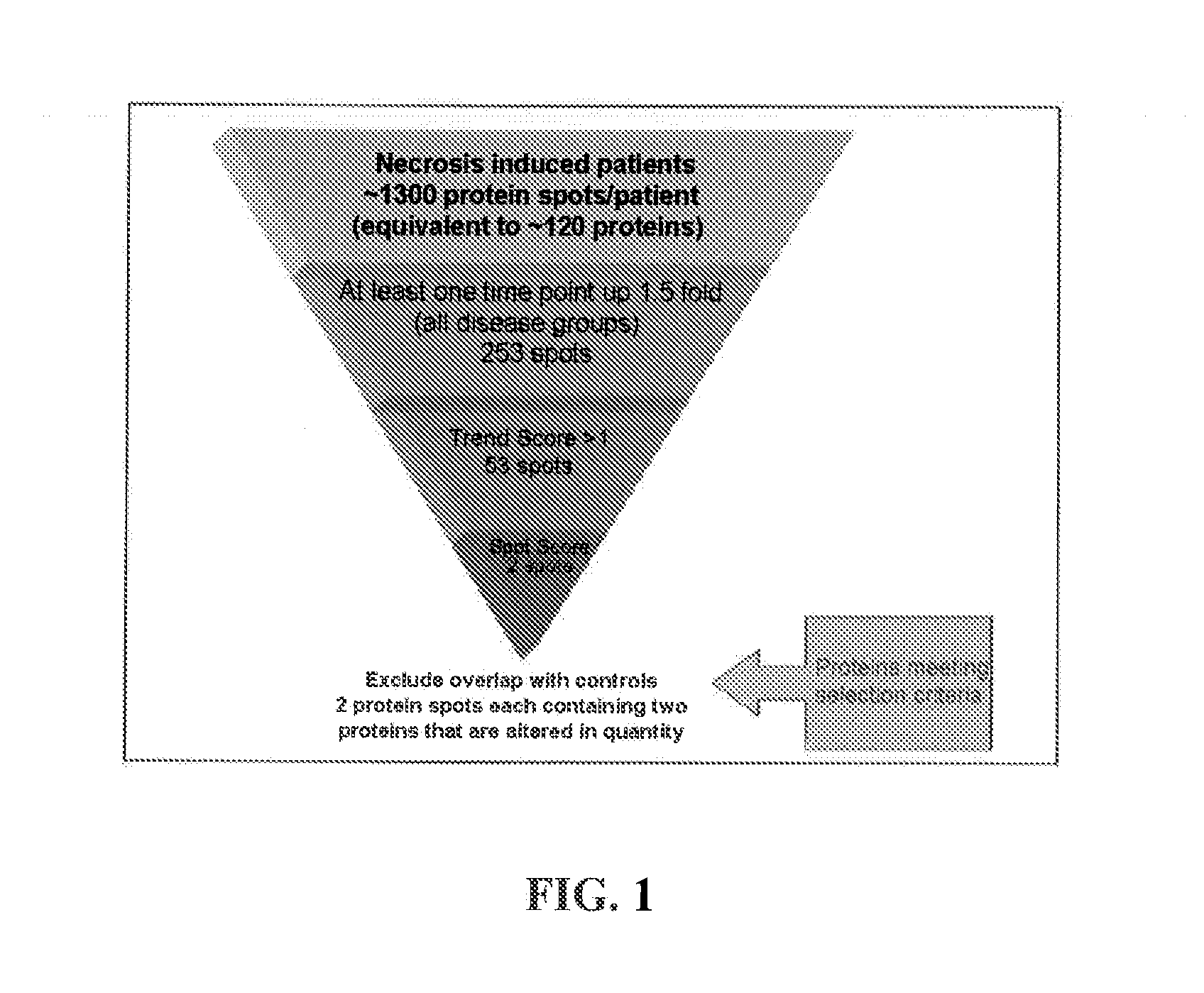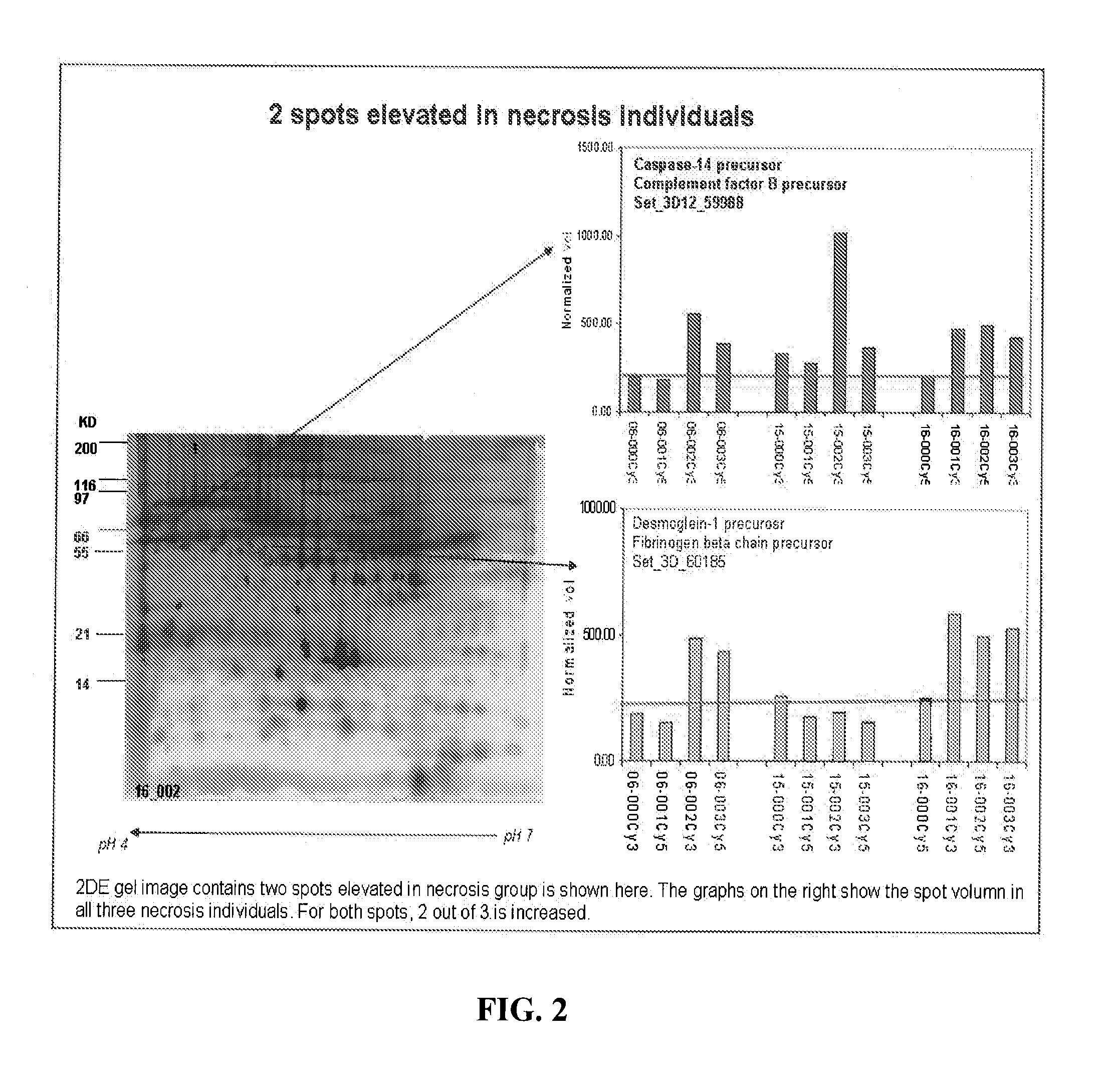Biomarkers for myocardial ischemia
a biomarker and myocardial ischemia technology, applied in the direction of depsipeptides, peptide/protein ingredients, particle separator tubes, etc., can solve the problem that the diagnosis of cardiac ischemia in the absence of necrosis cannot be made with accuracy
- Summary
- Abstract
- Description
- Claims
- Application Information
AI Technical Summary
Benefits of technology
Problems solved by technology
Method used
Image
Examples
example i
Identification of Novel Cardiac Biomarkers that are Rapidly Released into the Coronary Sinus in Response to Cardiac Ischemia, Even in the Absence of Detectable Myocyte Necrosis
A. Overview of the Studies
[0087]Rapid atrial pacing has been reported to produce reversible and controlled myocardial ischemia, as measured by a coronary sinus lactate concentration that rises above arterial lactate concentration, in approximately ⅔ of patients with fixed epicardial coronary artery disease (>70% diameter stenosis in at least one coronary artery). (Dehrner et al. (1983) Am Heart J 106, 114-24; Markham et al. (1983) Am J Cardiol 51, 1589-94). Therefore, in the experiments shown in this Example, atrial pacing was used as the human demand ischemia model.
[0088]In the studies shown in this Example, three types of protein analysis were conducted to identify protein markers of the invention. There is normally less than 40% overlap (e.g., 3-5) in the proteins observed between the different types of ana...
example ii
Summary of Some of the Properties of Proteins Discussed with Regard to Cohort I
A. Vitamin D-Binding Protein
[0141]Name: Vitamin D-binding protein
IPI ID: IPI00555812
[0142]UniProtKB / Swiss-Prot entry ID: P02774, Q16309, Q16310
Length: 474 aa, molecular weight: 52964 Da (of precursor)
1. Basic Information from UniProtKB / Swiss-Prot Entry[0143]FUNCTION: Multifunctional protein found in plasma, ascitic fluid, cerebrospinal fluid, and urine and on the surface of many cell types. In plasma, it carries the vitamin D sterols and prevents polymerization of actin by binding its monomers. DBP associates with membrane-bound immunoglobulin on the surface of B-lymphocytes and with IgG Fc receptor on the membranes of T-lymphocytes.[0144]SUBCELLULAR LOCATION: Secreted.[0145]POLYMORPHISM: Over 80 variants of human DBP have been identified. The three most common alleles are called GC*1F, GC*1S, and GC*2. The sequence shown is that of the GC*2 allele
2. Sequence
[0146]
(SEQ ID NO: 1)MKRVLVLLLAVAFGHALERGRDYEKNK...
example iii
Further Studies to Identify Cardiac Biomarkers, Using as a Cohort of Patients, a Valve Replacement Cardioplegia Human Model (Cohort II)
A. Overview of the Studies
[0272]The 21 patients in this cohort all underwent aortic valve replacement surgery (See FIGS. 6 and 7). Table 10 provides cohort information of this model.
TABLE 10patient samplingT1pre-op sample (before incision).T2immediately before the heart gets stopped (prior to CPB).T65 min after the heart went off CPB and was beating on itsown again.T730 min after bypassT860 min after bypassT9120 min after bypass
There were 6 plasma samples taken. Note that only 19 (out of 21) patients have samples at T9. The sample were normalized to total protein concentration for both targeted and de nova discovery. In the targeted analysis, 15 biomarkers were determined for each sample, specifically, CRP, GM-CSF, IFNγ, IL10, IL12p70, IL1β, IL-2, IL-6, IL-8, NT proBNP, SAA, TNFα, cTnI, sICAM, sVCAM. All time points were analyzed. These analyses were...
PUM
| Property | Measurement | Unit |
|---|---|---|
| Mass | aaaaa | aaaaa |
| Mass | aaaaa | aaaaa |
| Fraction | aaaaa | aaaaa |
Abstract
Description
Claims
Application Information
 Login to View More
Login to View More - R&D
- Intellectual Property
- Life Sciences
- Materials
- Tech Scout
- Unparalleled Data Quality
- Higher Quality Content
- 60% Fewer Hallucinations
Browse by: Latest US Patents, China's latest patents, Technical Efficacy Thesaurus, Application Domain, Technology Topic, Popular Technical Reports.
© 2025 PatSnap. All rights reserved.Legal|Privacy policy|Modern Slavery Act Transparency Statement|Sitemap|About US| Contact US: help@patsnap.com



